Visual Search: Anxiety, Information Processing Speed & Adults
VerifiedAdded on 2023/06/11
|46
|13333
|304
Report
AI Summary
This report investigates the influence of subclinical anxiety levels on information processing speed and intra-individual variability in younger and older adults, employing a visual search task. It examines how factors like non-clinical anxiety, subjective memory function, sex, and education impact information processing speed, addressing gaps in previous research. The study contrasts cognitive aging, marked by a decline in processing speed, with the rise in intra-individual variability (IIV) observed in older adults. It explores short-term variability, intraindividual variability across tasks, and intraindividual change, highlighting their significance in differentiating between healthy individuals and those with cognitive impairment. Furthermore, the report discusses the link between delayed cognition, information processing speed, and white and grey matter integrity, noting that slowed processing speeds correlate with structural changes affecting brain function. It emphasizes the need to consider factors like sex, education, and anxiety when interpreting information processing speed tests, particularly in clinical settings. The research aims to determine the potential of sub-clinical anxiety and subjective cognitive function to affect information processing speed in both younger and older adults, addressing concerns about cognitive decline and the early stages of dementia.
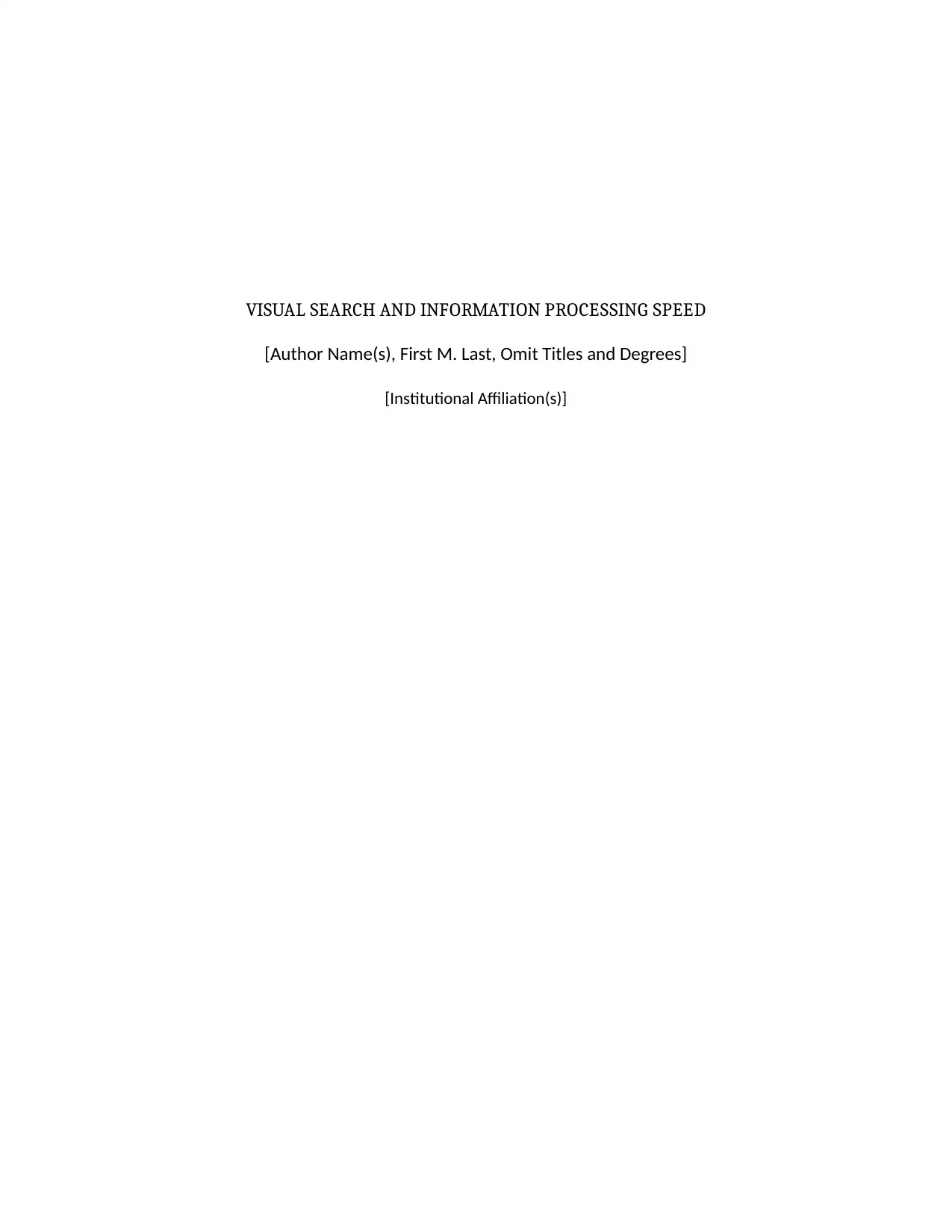
VISUAL SEARCH AND INFORMATION PROCESSING SPEED
[Author Name(s), First M. Last, Omit Titles and Degrees]
[Institutional Affiliation(s)]
[Author Name(s), First M. Last, Omit Titles and Degrees]
[Institutional Affiliation(s)]
Paraphrase This Document
Need a fresh take? Get an instant paraphrase of this document with our AI Paraphraser
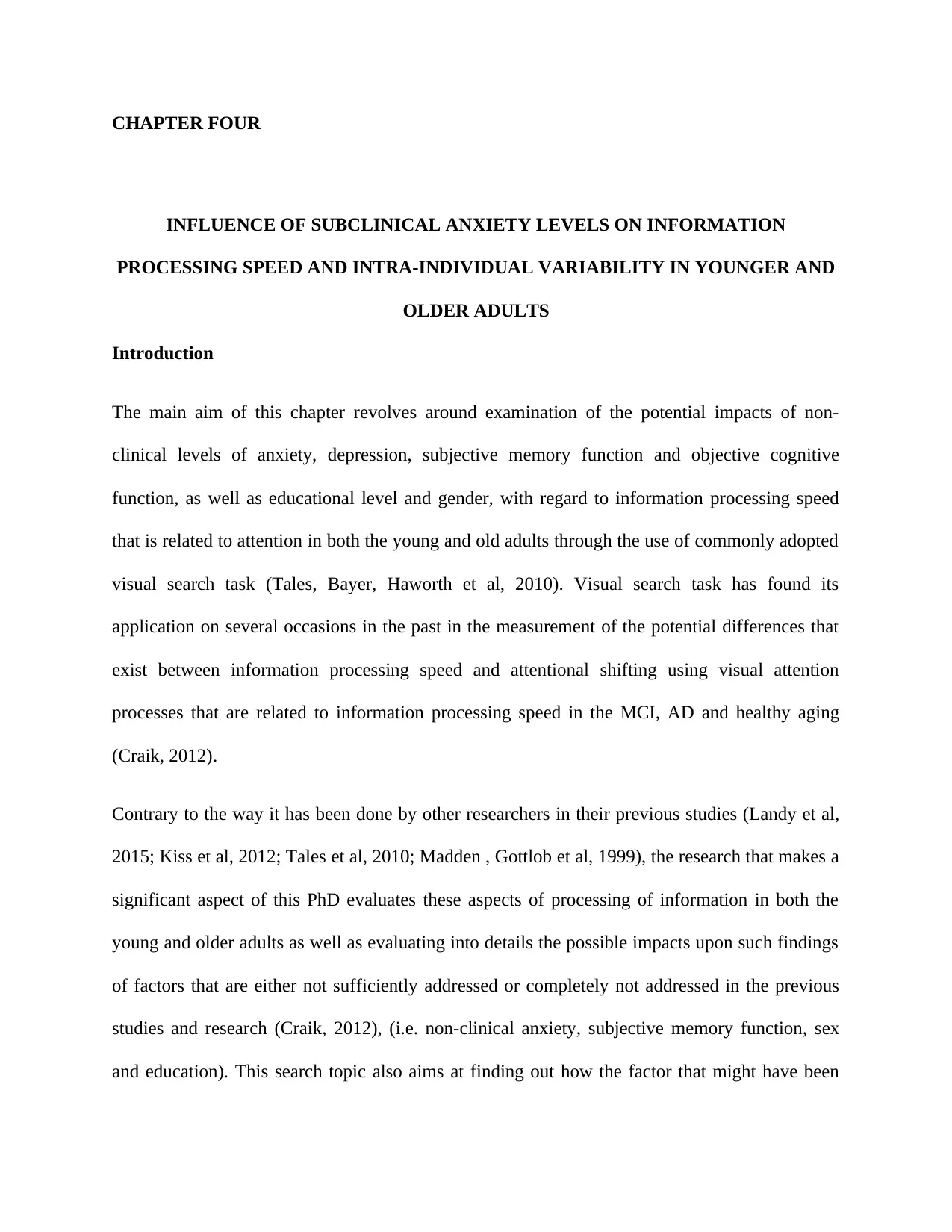
CHAPTER FOUR
INFLUENCE OF SUBCLINICAL ANXIETY LEVELS ON INFORMATION
PROCESSING SPEED AND INTRA-INDIVIDUAL VARIABILITY IN YOUNGER AND
OLDER ADULTS
Introduction
The main aim of this chapter revolves around examination of the potential impacts of non-
clinical levels of anxiety, depression, subjective memory function and objective cognitive
function, as well as educational level and gender, with regard to information processing speed
that is related to attention in both the young and old adults through the use of commonly adopted
visual search task (Tales, Bayer, Haworth et al, 2010). Visual search task has found its
application on several occasions in the past in the measurement of the potential differences that
exist between information processing speed and attentional shifting using visual attention
processes that are related to information processing speed in the MCI, AD and healthy aging
(Craik, 2012).
Contrary to the way it has been done by other researchers in their previous studies (Landy et al,
2015; Kiss et al, 2012; Tales et al, 2010; Madden , Gottlob et al, 1999), the research that makes a
significant aspect of this PhD evaluates these aspects of processing of information in both the
young and older adults as well as evaluating into details the possible impacts upon such findings
of factors that are either not sufficiently addressed or completely not addressed in the previous
studies and research (Craik, 2012), (i.e. non-clinical anxiety, subjective memory function, sex
and education). This search topic also aims at finding out how the factor that might have been
INFLUENCE OF SUBCLINICAL ANXIETY LEVELS ON INFORMATION
PROCESSING SPEED AND INTRA-INDIVIDUAL VARIABILITY IN YOUNGER AND
OLDER ADULTS
Introduction
The main aim of this chapter revolves around examination of the potential impacts of non-
clinical levels of anxiety, depression, subjective memory function and objective cognitive
function, as well as educational level and gender, with regard to information processing speed
that is related to attention in both the young and old adults through the use of commonly adopted
visual search task (Tales, Bayer, Haworth et al, 2010). Visual search task has found its
application on several occasions in the past in the measurement of the potential differences that
exist between information processing speed and attentional shifting using visual attention
processes that are related to information processing speed in the MCI, AD and healthy aging
(Craik, 2012).
Contrary to the way it has been done by other researchers in their previous studies (Landy et al,
2015; Kiss et al, 2012; Tales et al, 2010; Madden , Gottlob et al, 1999), the research that makes a
significant aspect of this PhD evaluates these aspects of processing of information in both the
young and older adults as well as evaluating into details the possible impacts upon such findings
of factors that are either not sufficiently addressed or completely not addressed in the previous
studies and research (Craik, 2012), (i.e. non-clinical anxiety, subjective memory function, sex
and education). This search topic also aims at finding out how the factor that might have been
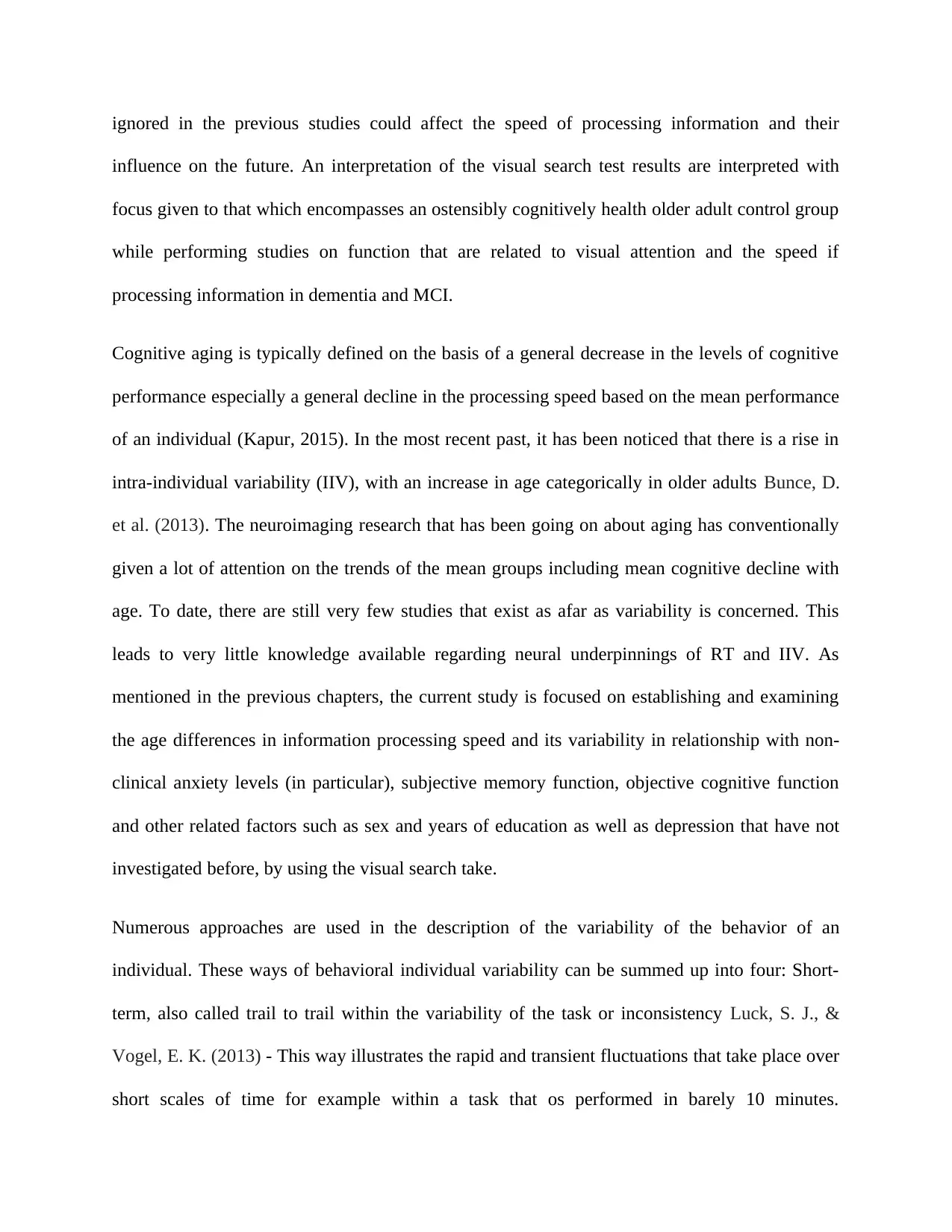
ignored in the previous studies could affect the speed of processing information and their
influence on the future. An interpretation of the visual search test results are interpreted with
focus given to that which encompasses an ostensibly cognitively health older adult control group
while performing studies on function that are related to visual attention and the speed if
processing information in dementia and MCI.
Cognitive aging is typically defined on the basis of a general decrease in the levels of cognitive
performance especially a general decline in the processing speed based on the mean performance
of an individual (Kapur, 2015). In the most recent past, it has been noticed that there is a rise in
intra-individual variability (IIV), with an increase in age categorically in older adults Bunce, D.
et al. (2013). The neuroimaging research that has been going on about aging has conventionally
given a lot of attention on the trends of the mean groups including mean cognitive decline with
age. To date, there are still very few studies that exist as afar as variability is concerned. This
leads to very little knowledge available regarding neural underpinnings of RT and IIV. As
mentioned in the previous chapters, the current study is focused on establishing and examining
the age differences in information processing speed and its variability in relationship with non-
clinical anxiety levels (in particular), subjective memory function, objective cognitive function
and other related factors such as sex and years of education as well as depression that have not
investigated before, by using the visual search take.
Numerous approaches are used in the description of the variability of the behavior of an
individual. These ways of behavioral individual variability can be summed up into four: Short-
term, also called trail to trail within the variability of the task or inconsistency Luck, S. J., &
Vogel, E. K. (2013) - This way illustrates the rapid and transient fluctuations that take place over
short scales of time for example within a task that os performed in barely 10 minutes.
influence on the future. An interpretation of the visual search test results are interpreted with
focus given to that which encompasses an ostensibly cognitively health older adult control group
while performing studies on function that are related to visual attention and the speed if
processing information in dementia and MCI.
Cognitive aging is typically defined on the basis of a general decrease in the levels of cognitive
performance especially a general decline in the processing speed based on the mean performance
of an individual (Kapur, 2015). In the most recent past, it has been noticed that there is a rise in
intra-individual variability (IIV), with an increase in age categorically in older adults Bunce, D.
et al. (2013). The neuroimaging research that has been going on about aging has conventionally
given a lot of attention on the trends of the mean groups including mean cognitive decline with
age. To date, there are still very few studies that exist as afar as variability is concerned. This
leads to very little knowledge available regarding neural underpinnings of RT and IIV. As
mentioned in the previous chapters, the current study is focused on establishing and examining
the age differences in information processing speed and its variability in relationship with non-
clinical anxiety levels (in particular), subjective memory function, objective cognitive function
and other related factors such as sex and years of education as well as depression that have not
investigated before, by using the visual search take.
Numerous approaches are used in the description of the variability of the behavior of an
individual. These ways of behavioral individual variability can be summed up into four: Short-
term, also called trail to trail within the variability of the task or inconsistency Luck, S. J., &
Vogel, E. K. (2013) - This way illustrates the rapid and transient fluctuations that take place over
short scales of time for example within a task that os performed in barely 10 minutes.
⊘ This is a preview!⊘
Do you want full access?
Subscribe today to unlock all pages.

Trusted by 1+ million students worldwide
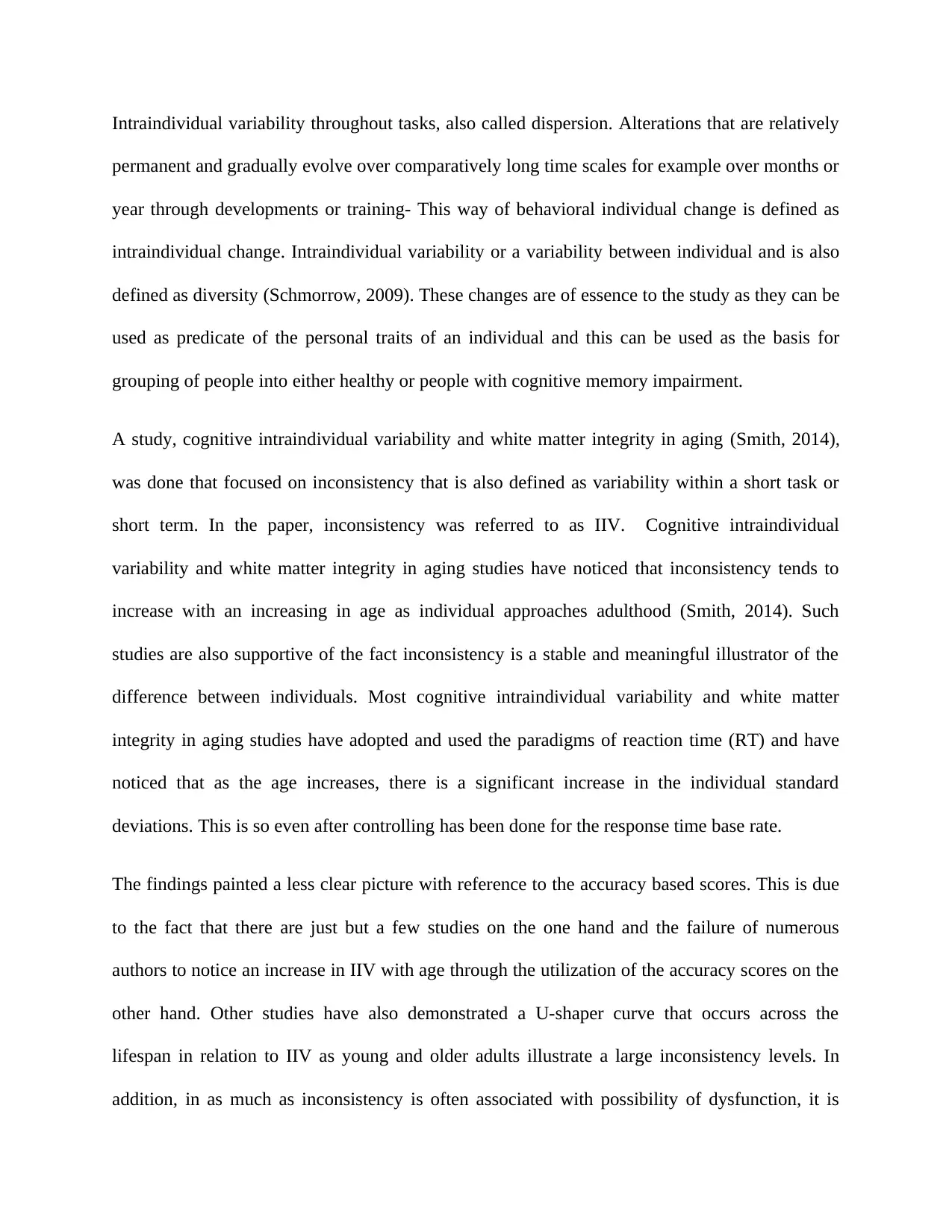
Intraindividual variability throughout tasks, also called dispersion. Alterations that are relatively
permanent and gradually evolve over comparatively long time scales for example over months or
year through developments or training- This way of behavioral individual change is defined as
intraindividual change. Intraindividual variability or a variability between individual and is also
defined as diversity (Schmorrow, 2009). These changes are of essence to the study as they can be
used as predicate of the personal traits of an individual and this can be used as the basis for
grouping of people into either healthy or people with cognitive memory impairment.
A study, cognitive intraindividual variability and white matter integrity in aging (Smith, 2014),
was done that focused on inconsistency that is also defined as variability within a short task or
short term. In the paper, inconsistency was referred to as IIV. Cognitive intraindividual
variability and white matter integrity in aging studies have noticed that inconsistency tends to
increase with an increasing in age as individual approaches adulthood (Smith, 2014). Such
studies are also supportive of the fact inconsistency is a stable and meaningful illustrator of the
difference between individuals. Most cognitive intraindividual variability and white matter
integrity in aging studies have adopted and used the paradigms of reaction time (RT) and have
noticed that as the age increases, there is a significant increase in the individual standard
deviations. This is so even after controlling has been done for the response time base rate.
The findings painted a less clear picture with reference to the accuracy based scores. This is due
to the fact that there are just but a few studies on the one hand and the failure of numerous
authors to notice an increase in IIV with age through the utilization of the accuracy scores on the
other hand. Other studies have also demonstrated a U-shaper curve that occurs across the
lifespan in relation to IIV as young and older adults illustrate a large inconsistency levels. In
addition, in as much as inconsistency is often associated with possibility of dysfunction, it is
permanent and gradually evolve over comparatively long time scales for example over months or
year through developments or training- This way of behavioral individual change is defined as
intraindividual change. Intraindividual variability or a variability between individual and is also
defined as diversity (Schmorrow, 2009). These changes are of essence to the study as they can be
used as predicate of the personal traits of an individual and this can be used as the basis for
grouping of people into either healthy or people with cognitive memory impairment.
A study, cognitive intraindividual variability and white matter integrity in aging (Smith, 2014),
was done that focused on inconsistency that is also defined as variability within a short task or
short term. In the paper, inconsistency was referred to as IIV. Cognitive intraindividual
variability and white matter integrity in aging studies have noticed that inconsistency tends to
increase with an increasing in age as individual approaches adulthood (Smith, 2014). Such
studies are also supportive of the fact inconsistency is a stable and meaningful illustrator of the
difference between individuals. Most cognitive intraindividual variability and white matter
integrity in aging studies have adopted and used the paradigms of reaction time (RT) and have
noticed that as the age increases, there is a significant increase in the individual standard
deviations. This is so even after controlling has been done for the response time base rate.
The findings painted a less clear picture with reference to the accuracy based scores. This is due
to the fact that there are just but a few studies on the one hand and the failure of numerous
authors to notice an increase in IIV with age through the utilization of the accuracy scores on the
other hand. Other studies have also demonstrated a U-shaper curve that occurs across the
lifespan in relation to IIV as young and older adults illustrate a large inconsistency levels. In
addition, in as much as inconsistency is often associated with possibility of dysfunction, it is
Paraphrase This Document
Need a fresh take? Get an instant paraphrase of this document with our AI Paraphraser
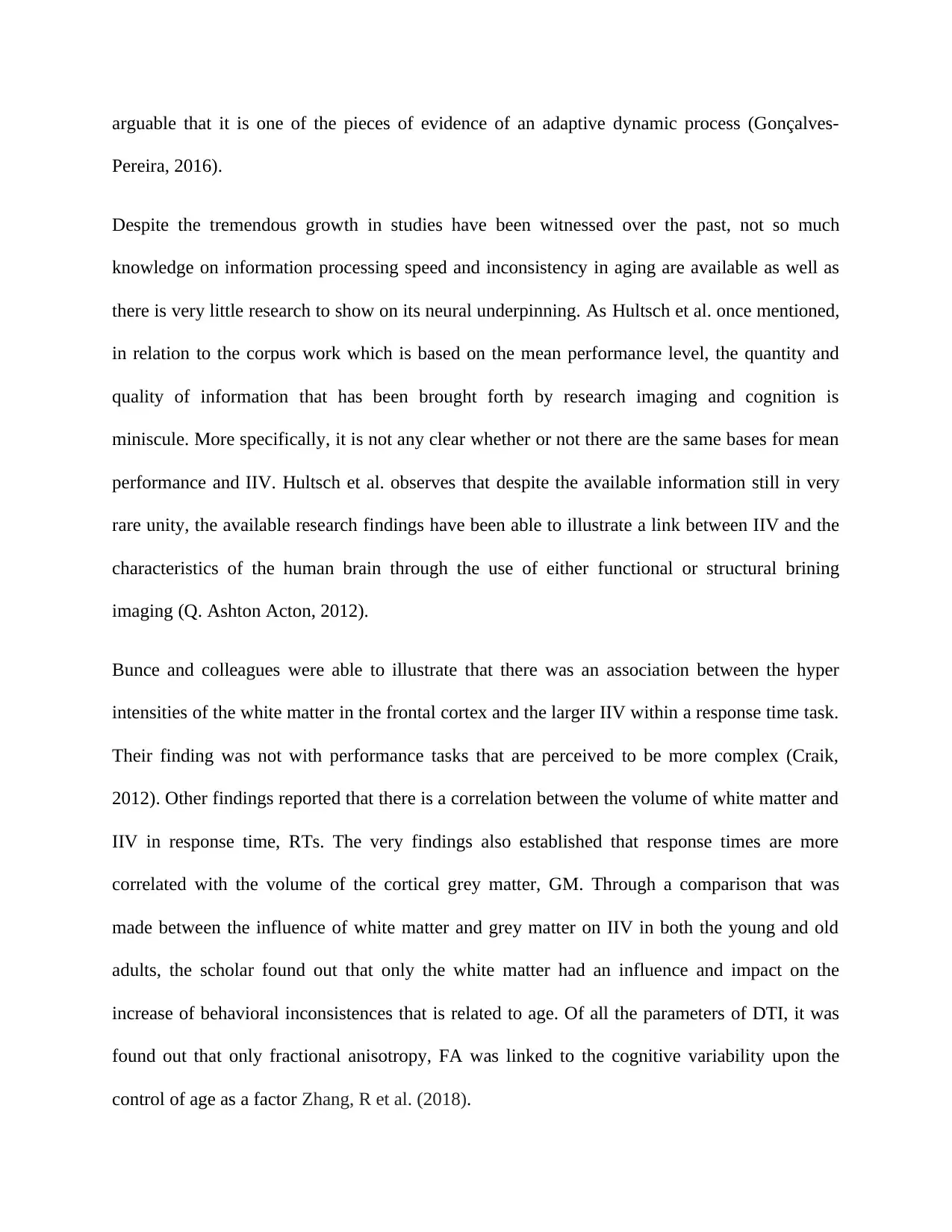
arguable that it is one of the pieces of evidence of an adaptive dynamic process (Gonçalves-
Pereira, 2016).
Despite the tremendous growth in studies have been witnessed over the past, not so much
knowledge on information processing speed and inconsistency in aging are available as well as
there is very little research to show on its neural underpinning. As Hultsch et al. once mentioned,
in relation to the corpus work which is based on the mean performance level, the quantity and
quality of information that has been brought forth by research imaging and cognition is
miniscule. More specifically, it is not any clear whether or not there are the same bases for mean
performance and IIV. Hultsch et al. observes that despite the available information still in very
rare unity, the available research findings have been able to illustrate a link between IIV and the
characteristics of the human brain through the use of either functional or structural brining
imaging (Q. Ashton Acton, 2012).
Bunce and colleagues were able to illustrate that there was an association between the hyper
intensities of the white matter in the frontal cortex and the larger IIV within a response time task.
Their finding was not with performance tasks that are perceived to be more complex (Craik,
2012). Other findings reported that there is a correlation between the volume of white matter and
IIV in response time, RTs. The very findings also established that response times are more
correlated with the volume of the cortical grey matter, GM. Through a comparison that was
made between the influence of white matter and grey matter on IIV in both the young and old
adults, the scholar found out that only the white matter had an influence and impact on the
increase of behavioral inconsistences that is related to age. Of all the parameters of DTI, it was
found out that only fractional anisotropy, FA was linked to the cognitive variability upon the
control of age as a factor Zhang, R et al. (2018).
Pereira, 2016).
Despite the tremendous growth in studies have been witnessed over the past, not so much
knowledge on information processing speed and inconsistency in aging are available as well as
there is very little research to show on its neural underpinning. As Hultsch et al. once mentioned,
in relation to the corpus work which is based on the mean performance level, the quantity and
quality of information that has been brought forth by research imaging and cognition is
miniscule. More specifically, it is not any clear whether or not there are the same bases for mean
performance and IIV. Hultsch et al. observes that despite the available information still in very
rare unity, the available research findings have been able to illustrate a link between IIV and the
characteristics of the human brain through the use of either functional or structural brining
imaging (Q. Ashton Acton, 2012).
Bunce and colleagues were able to illustrate that there was an association between the hyper
intensities of the white matter in the frontal cortex and the larger IIV within a response time task.
Their finding was not with performance tasks that are perceived to be more complex (Craik,
2012). Other findings reported that there is a correlation between the volume of white matter and
IIV in response time, RTs. The very findings also established that response times are more
correlated with the volume of the cortical grey matter, GM. Through a comparison that was
made between the influence of white matter and grey matter on IIV in both the young and old
adults, the scholar found out that only the white matter had an influence and impact on the
increase of behavioral inconsistences that is related to age. Of all the parameters of DTI, it was
found out that only fractional anisotropy, FA was linked to the cognitive variability upon the
control of age as a factor Zhang, R et al. (2018).
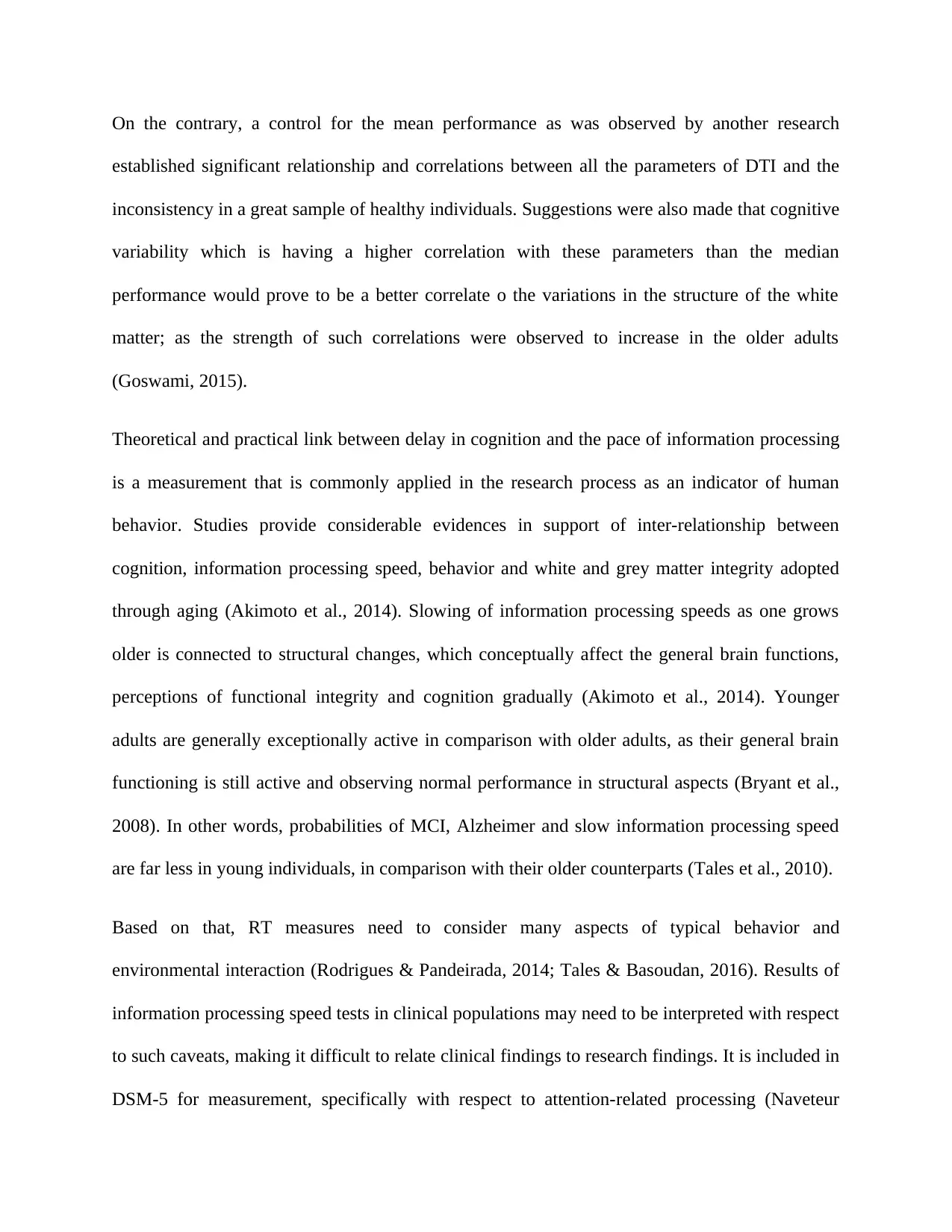
On the contrary, a control for the mean performance as was observed by another research
established significant relationship and correlations between all the parameters of DTI and the
inconsistency in a great sample of healthy individuals. Suggestions were also made that cognitive
variability which is having a higher correlation with these parameters than the median
performance would prove to be a better correlate o the variations in the structure of the white
matter; as the strength of such correlations were observed to increase in the older adults
(Goswami, 2015).
Theoretical and practical link between delay in cognition and the pace of information processing
is a measurement that is commonly applied in the research process as an indicator of human
behavior. Studies provide considerable evidences in support of inter-relationship between
cognition, information processing speed, behavior and white and grey matter integrity adopted
through aging (Akimoto et al., 2014). Slowing of information processing speeds as one grows
older is connected to structural changes, which conceptually affect the general brain functions,
perceptions of functional integrity and cognition gradually (Akimoto et al., 2014). Younger
adults are generally exceptionally active in comparison with older adults, as their general brain
functioning is still active and observing normal performance in structural aspects (Bryant et al.,
2008). In other words, probabilities of MCI, Alzheimer and slow information processing speed
are far less in young individuals, in comparison with their older counterparts (Tales et al., 2010).
Based on that, RT measures need to consider many aspects of typical behavior and
environmental interaction (Rodrigues & Pandeirada, 2014; Tales & Basoudan, 2016). Results of
information processing speed tests in clinical populations may need to be interpreted with respect
to such caveats, making it difficult to relate clinical findings to research findings. It is included in
DSM-5 for measurement, specifically with respect to attention-related processing (Naveteur
established significant relationship and correlations between all the parameters of DTI and the
inconsistency in a great sample of healthy individuals. Suggestions were also made that cognitive
variability which is having a higher correlation with these parameters than the median
performance would prove to be a better correlate o the variations in the structure of the white
matter; as the strength of such correlations were observed to increase in the older adults
(Goswami, 2015).
Theoretical and practical link between delay in cognition and the pace of information processing
is a measurement that is commonly applied in the research process as an indicator of human
behavior. Studies provide considerable evidences in support of inter-relationship between
cognition, information processing speed, behavior and white and grey matter integrity adopted
through aging (Akimoto et al., 2014). Slowing of information processing speeds as one grows
older is connected to structural changes, which conceptually affect the general brain functions,
perceptions of functional integrity and cognition gradually (Akimoto et al., 2014). Younger
adults are generally exceptionally active in comparison with older adults, as their general brain
functioning is still active and observing normal performance in structural aspects (Bryant et al.,
2008). In other words, probabilities of MCI, Alzheimer and slow information processing speed
are far less in young individuals, in comparison with their older counterparts (Tales et al., 2010).
Based on that, RT measures need to consider many aspects of typical behavior and
environmental interaction (Rodrigues & Pandeirada, 2014; Tales & Basoudan, 2016). Results of
information processing speed tests in clinical populations may need to be interpreted with respect
to such caveats, making it difficult to relate clinical findings to research findings. It is included in
DSM-5 for measurement, specifically with respect to attention-related processing (Naveteur
⊘ This is a preview!⊘
Do you want full access?
Subscribe today to unlock all pages.

Trusted by 1+ million students worldwide
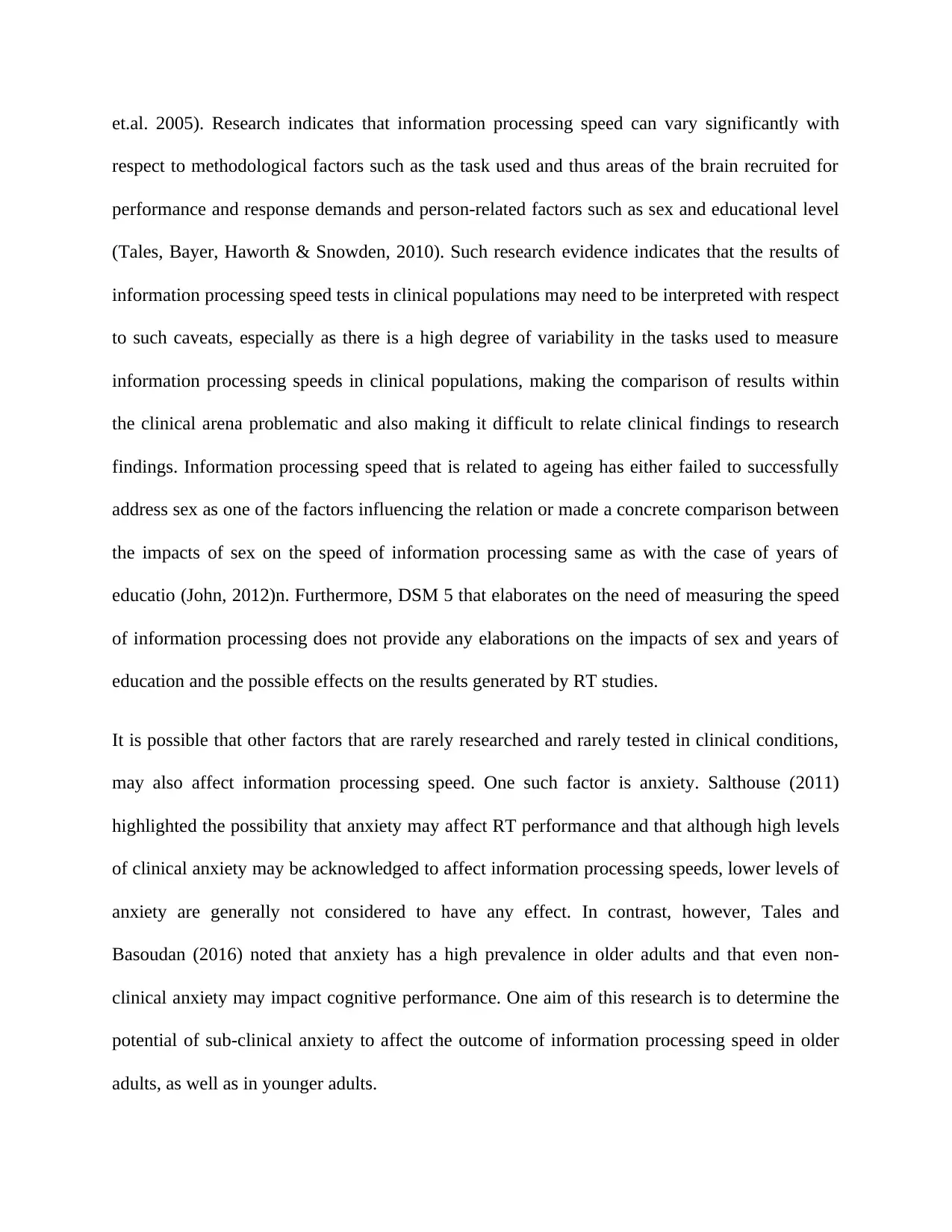
et.al. 2005). Research indicates that information processing speed can vary significantly with
respect to methodological factors such as the task used and thus areas of the brain recruited for
performance and response demands and person-related factors such as sex and educational level
(Tales, Bayer, Haworth & Snowden, 2010). Such research evidence indicates that the results of
information processing speed tests in clinical populations may need to be interpreted with respect
to such caveats, especially as there is a high degree of variability in the tasks used to measure
information processing speeds in clinical populations, making the comparison of results within
the clinical arena problematic and also making it difficult to relate clinical findings to research
findings. Information processing speed that is related to ageing has either failed to successfully
address sex as one of the factors influencing the relation or made a concrete comparison between
the impacts of sex on the speed of information processing same as with the case of years of
educatio (John, 2012)n. Furthermore, DSM 5 that elaborates on the need of measuring the speed
of information processing does not provide any elaborations on the impacts of sex and years of
education and the possible effects on the results generated by RT studies.
It is possible that other factors that are rarely researched and rarely tested in clinical conditions,
may also affect information processing speed. One such factor is anxiety. Salthouse (2011)
highlighted the possibility that anxiety may affect RT performance and that although high levels
of clinical anxiety may be acknowledged to affect information processing speeds, lower levels of
anxiety are generally not considered to have any effect. In contrast, however, Tales and
Basoudan (2016) noted that anxiety has a high prevalence in older adults and that even non-
clinical anxiety may impact cognitive performance. One aim of this research is to determine the
potential of sub-clinical anxiety to affect the outcome of information processing speed in older
adults, as well as in younger adults.
respect to methodological factors such as the task used and thus areas of the brain recruited for
performance and response demands and person-related factors such as sex and educational level
(Tales, Bayer, Haworth & Snowden, 2010). Such research evidence indicates that the results of
information processing speed tests in clinical populations may need to be interpreted with respect
to such caveats, especially as there is a high degree of variability in the tasks used to measure
information processing speeds in clinical populations, making the comparison of results within
the clinical arena problematic and also making it difficult to relate clinical findings to research
findings. Information processing speed that is related to ageing has either failed to successfully
address sex as one of the factors influencing the relation or made a concrete comparison between
the impacts of sex on the speed of information processing same as with the case of years of
educatio (John, 2012)n. Furthermore, DSM 5 that elaborates on the need of measuring the speed
of information processing does not provide any elaborations on the impacts of sex and years of
education and the possible effects on the results generated by RT studies.
It is possible that other factors that are rarely researched and rarely tested in clinical conditions,
may also affect information processing speed. One such factor is anxiety. Salthouse (2011)
highlighted the possibility that anxiety may affect RT performance and that although high levels
of clinical anxiety may be acknowledged to affect information processing speeds, lower levels of
anxiety are generally not considered to have any effect. In contrast, however, Tales and
Basoudan (2016) noted that anxiety has a high prevalence in older adults and that even non-
clinical anxiety may impact cognitive performance. One aim of this research is to determine the
potential of sub-clinical anxiety to affect the outcome of information processing speed in older
adults, as well as in younger adults.
Paraphrase This Document
Need a fresh take? Get an instant paraphrase of this document with our AI Paraphraser
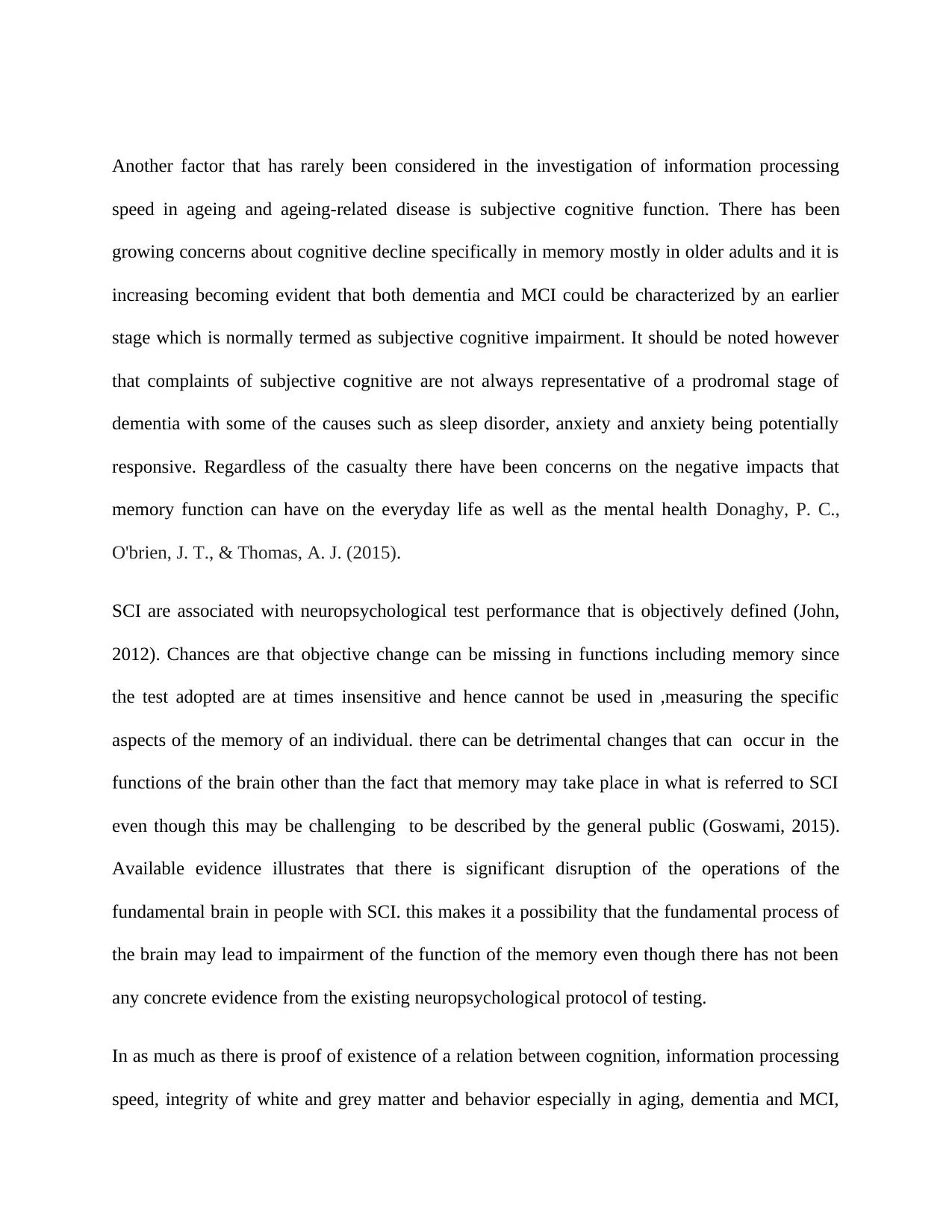
Another factor that has rarely been considered in the investigation of information processing
speed in ageing and ageing-related disease is subjective cognitive function. There has been
growing concerns about cognitive decline specifically in memory mostly in older adults and it is
increasing becoming evident that both dementia and MCI could be characterized by an earlier
stage which is normally termed as subjective cognitive impairment. It should be noted however
that complaints of subjective cognitive are not always representative of a prodromal stage of
dementia with some of the causes such as sleep disorder, anxiety and anxiety being potentially
responsive. Regardless of the casualty there have been concerns on the negative impacts that
memory function can have on the everyday life as well as the mental health Donaghy, P. C.,
O'brien, J. T., & Thomas, A. J. (2015).
SCI are associated with neuropsychological test performance that is objectively defined (John,
2012). Chances are that objective change can be missing in functions including memory since
the test adopted are at times insensitive and hence cannot be used in ,measuring the specific
aspects of the memory of an individual. there can be detrimental changes that can occur in the
functions of the brain other than the fact that memory may take place in what is referred to SCI
even though this may be challenging to be described by the general public (Goswami, 2015).
Available evidence illustrates that there is significant disruption of the operations of the
fundamental brain in people with SCI. this makes it a possibility that the fundamental process of
the brain may lead to impairment of the function of the memory even though there has not been
any concrete evidence from the existing neuropsychological protocol of testing.
In as much as there is proof of existence of a relation between cognition, information processing
speed, integrity of white and grey matter and behavior especially in aging, dementia and MCI,
speed in ageing and ageing-related disease is subjective cognitive function. There has been
growing concerns about cognitive decline specifically in memory mostly in older adults and it is
increasing becoming evident that both dementia and MCI could be characterized by an earlier
stage which is normally termed as subjective cognitive impairment. It should be noted however
that complaints of subjective cognitive are not always representative of a prodromal stage of
dementia with some of the causes such as sleep disorder, anxiety and anxiety being potentially
responsive. Regardless of the casualty there have been concerns on the negative impacts that
memory function can have on the everyday life as well as the mental health Donaghy, P. C.,
O'brien, J. T., & Thomas, A. J. (2015).
SCI are associated with neuropsychological test performance that is objectively defined (John,
2012). Chances are that objective change can be missing in functions including memory since
the test adopted are at times insensitive and hence cannot be used in ,measuring the specific
aspects of the memory of an individual. there can be detrimental changes that can occur in the
functions of the brain other than the fact that memory may take place in what is referred to SCI
even though this may be challenging to be described by the general public (Goswami, 2015).
Available evidence illustrates that there is significant disruption of the operations of the
fundamental brain in people with SCI. this makes it a possibility that the fundamental process of
the brain may lead to impairment of the function of the memory even though there has not been
any concrete evidence from the existing neuropsychological protocol of testing.
In as much as there is proof of existence of a relation between cognition, information processing
speed, integrity of white and grey matter and behavior especially in aging, dementia and MCI,
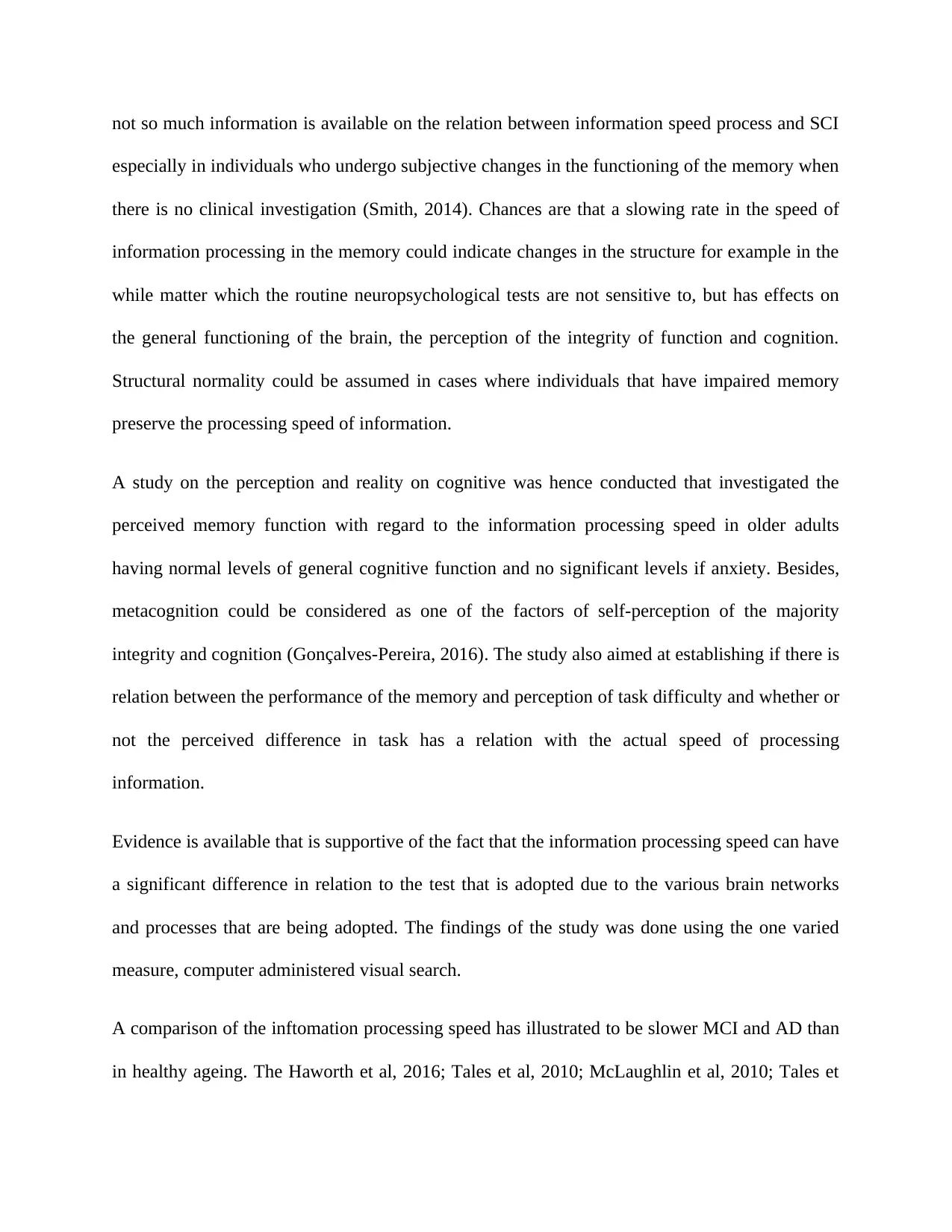
not so much information is available on the relation between information speed process and SCI
especially in individuals who undergo subjective changes in the functioning of the memory when
there is no clinical investigation (Smith, 2014). Chances are that a slowing rate in the speed of
information processing in the memory could indicate changes in the structure for example in the
while matter which the routine neuropsychological tests are not sensitive to, but has effects on
the general functioning of the brain, the perception of the integrity of function and cognition.
Structural normality could be assumed in cases where individuals that have impaired memory
preserve the processing speed of information.
A study on the perception and reality on cognitive was hence conducted that investigated the
perceived memory function with regard to the information processing speed in older adults
having normal levels of general cognitive function and no significant levels if anxiety. Besides,
metacognition could be considered as one of the factors of self-perception of the majority
integrity and cognition (Gonçalves-Pereira, 2016). The study also aimed at establishing if there is
relation between the performance of the memory and perception of task difficulty and whether or
not the perceived difference in task has a relation with the actual speed of processing
information.
Evidence is available that is supportive of the fact that the information processing speed can have
a significant difference in relation to the test that is adopted due to the various brain networks
and processes that are being adopted. The findings of the study was done using the one varied
measure, computer administered visual search.
A comparison of the inftomation processing speed has illustrated to be slower MCI and AD than
in healthy ageing. The Haworth et al, 2016; Tales et al, 2010; McLaughlin et al, 2010; Tales et
especially in individuals who undergo subjective changes in the functioning of the memory when
there is no clinical investigation (Smith, 2014). Chances are that a slowing rate in the speed of
information processing in the memory could indicate changes in the structure for example in the
while matter which the routine neuropsychological tests are not sensitive to, but has effects on
the general functioning of the brain, the perception of the integrity of function and cognition.
Structural normality could be assumed in cases where individuals that have impaired memory
preserve the processing speed of information.
A study on the perception and reality on cognitive was hence conducted that investigated the
perceived memory function with regard to the information processing speed in older adults
having normal levels of general cognitive function and no significant levels if anxiety. Besides,
metacognition could be considered as one of the factors of self-perception of the majority
integrity and cognition (Gonçalves-Pereira, 2016). The study also aimed at establishing if there is
relation between the performance of the memory and perception of task difficulty and whether or
not the perceived difference in task has a relation with the actual speed of processing
information.
Evidence is available that is supportive of the fact that the information processing speed can have
a significant difference in relation to the test that is adopted due to the various brain networks
and processes that are being adopted. The findings of the study was done using the one varied
measure, computer administered visual search.
A comparison of the inftomation processing speed has illustrated to be slower MCI and AD than
in healthy ageing. The Haworth et al, 2016; Tales et al, 2010; McLaughlin et al, 2010; Tales et
⊘ This is a preview!⊘
Do you want full access?
Subscribe today to unlock all pages.

Trusted by 1+ million students worldwide
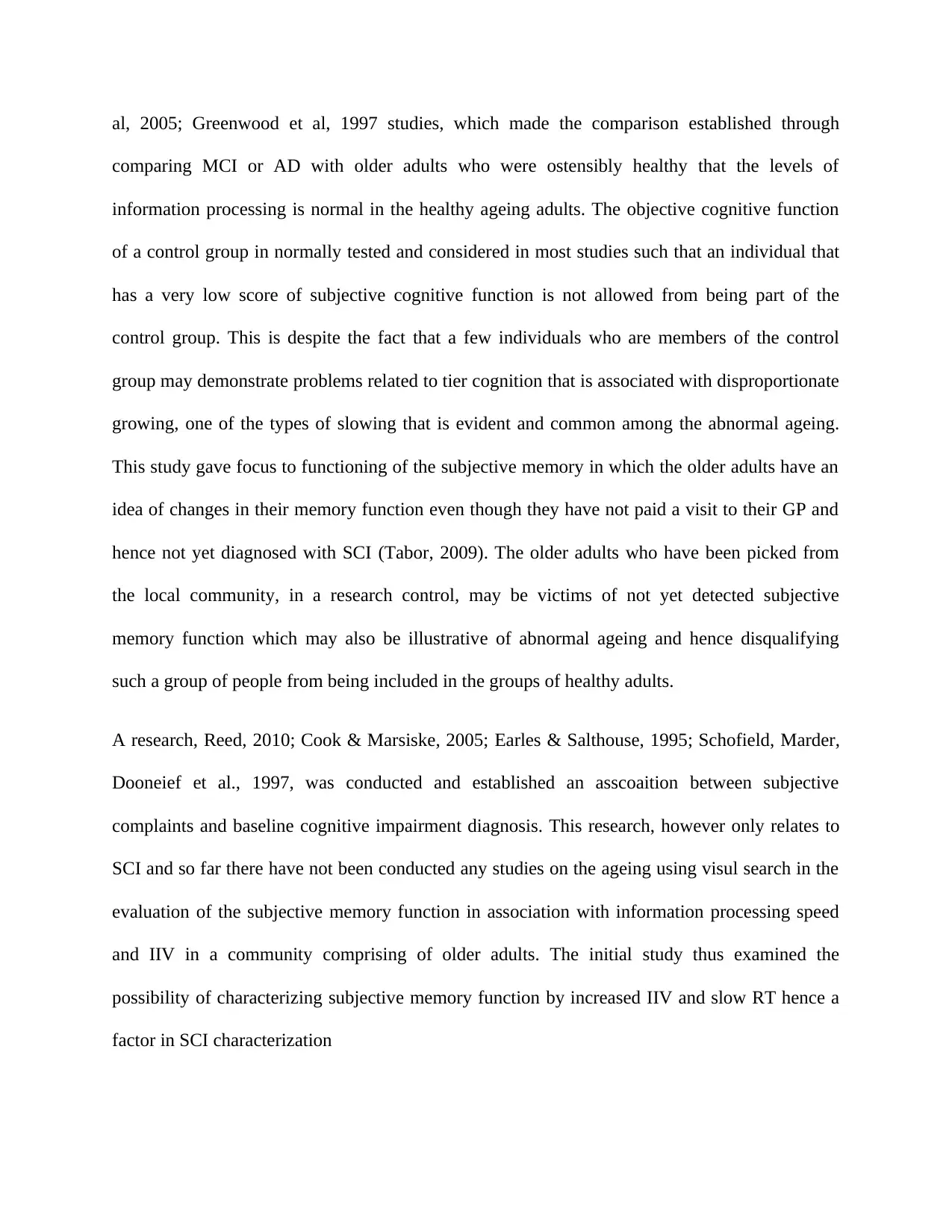
al, 2005; Greenwood et al, 1997 studies, which made the comparison established through
comparing MCI or AD with older adults who were ostensibly healthy that the levels of
information processing is normal in the healthy ageing adults. The objective cognitive function
of a control group in normally tested and considered in most studies such that an individual that
has a very low score of subjective cognitive function is not allowed from being part of the
control group. This is despite the fact that a few individuals who are members of the control
group may demonstrate problems related to tier cognition that is associated with disproportionate
growing, one of the types of slowing that is evident and common among the abnormal ageing.
This study gave focus to functioning of the subjective memory in which the older adults have an
idea of changes in their memory function even though they have not paid a visit to their GP and
hence not yet diagnosed with SCI (Tabor, 2009). The older adults who have been picked from
the local community, in a research control, may be victims of not yet detected subjective
memory function which may also be illustrative of abnormal ageing and hence disqualifying
such a group of people from being included in the groups of healthy adults.
A research, Reed, 2010; Cook & Marsiske, 2005; Earles & Salthouse, 1995; Schofield, Marder,
Dooneief et al., 1997, was conducted and established an asscoaition between subjective
complaints and baseline cognitive impairment diagnosis. This research, however only relates to
SCI and so far there have not been conducted any studies on the ageing using visul search in the
evaluation of the subjective memory function in association with information processing speed
and IIV in a community comprising of older adults. The initial study thus examined the
possibility of characterizing subjective memory function by increased IIV and slow RT hence a
factor in SCI characterization
comparing MCI or AD with older adults who were ostensibly healthy that the levels of
information processing is normal in the healthy ageing adults. The objective cognitive function
of a control group in normally tested and considered in most studies such that an individual that
has a very low score of subjective cognitive function is not allowed from being part of the
control group. This is despite the fact that a few individuals who are members of the control
group may demonstrate problems related to tier cognition that is associated with disproportionate
growing, one of the types of slowing that is evident and common among the abnormal ageing.
This study gave focus to functioning of the subjective memory in which the older adults have an
idea of changes in their memory function even though they have not paid a visit to their GP and
hence not yet diagnosed with SCI (Tabor, 2009). The older adults who have been picked from
the local community, in a research control, may be victims of not yet detected subjective
memory function which may also be illustrative of abnormal ageing and hence disqualifying
such a group of people from being included in the groups of healthy adults.
A research, Reed, 2010; Cook & Marsiske, 2005; Earles & Salthouse, 1995; Schofield, Marder,
Dooneief et al., 1997, was conducted and established an asscoaition between subjective
complaints and baseline cognitive impairment diagnosis. This research, however only relates to
SCI and so far there have not been conducted any studies on the ageing using visul search in the
evaluation of the subjective memory function in association with information processing speed
and IIV in a community comprising of older adults. The initial study thus examined the
possibility of characterizing subjective memory function by increased IIV and slow RT hence a
factor in SCI characterization
Paraphrase This Document
Need a fresh take? Get an instant paraphrase of this document with our AI Paraphraser
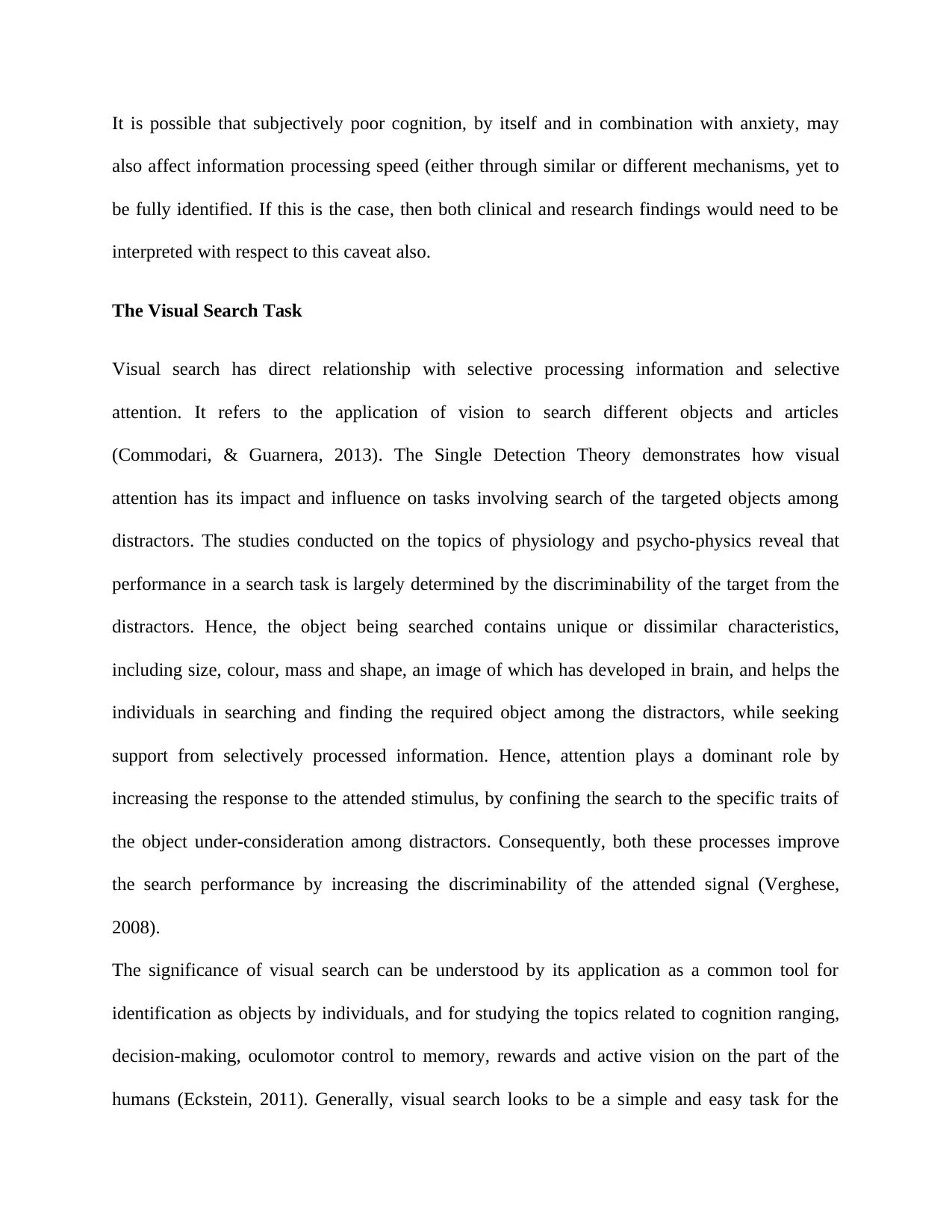
It is possible that subjectively poor cognition, by itself and in combination with anxiety, may
also affect information processing speed (either through similar or different mechanisms, yet to
be fully identified. If this is the case, then both clinical and research findings would need to be
interpreted with respect to this caveat also.
The Visual Search Task
Visual search has direct relationship with selective processing information and selective
attention. It refers to the application of vision to search different objects and articles
(Commodari, & Guarnera, 2013). The Single Detection Theory demonstrates how visual
attention has its impact and influence on tasks involving search of the targeted objects among
distractors. The studies conducted on the topics of physiology and psycho-physics reveal that
performance in a search task is largely determined by the discriminability of the target from the
distractors. Hence, the object being searched contains unique or dissimilar characteristics,
including size, colour, mass and shape, an image of which has developed in brain, and helps the
individuals in searching and finding the required object among the distractors, while seeking
support from selectively processed information. Hence, attention plays a dominant role by
increasing the response to the attended stimulus, by confining the search to the specific traits of
the object under-consideration among distractors. Consequently, both these processes improve
the search performance by increasing the discriminability of the attended signal (Verghese,
2008).
The significance of visual search can be understood by its application as a common tool for
identification as objects by individuals, and for studying the topics related to cognition ranging,
decision-making, oculomotor control to memory, rewards and active vision on the part of the
humans (Eckstein, 2011). Generally, visual search looks to be a simple and easy task for the
also affect information processing speed (either through similar or different mechanisms, yet to
be fully identified. If this is the case, then both clinical and research findings would need to be
interpreted with respect to this caveat also.
The Visual Search Task
Visual search has direct relationship with selective processing information and selective
attention. It refers to the application of vision to search different objects and articles
(Commodari, & Guarnera, 2013). The Single Detection Theory demonstrates how visual
attention has its impact and influence on tasks involving search of the targeted objects among
distractors. The studies conducted on the topics of physiology and psycho-physics reveal that
performance in a search task is largely determined by the discriminability of the target from the
distractors. Hence, the object being searched contains unique or dissimilar characteristics,
including size, colour, mass and shape, an image of which has developed in brain, and helps the
individuals in searching and finding the required object among the distractors, while seeking
support from selectively processed information. Hence, attention plays a dominant role by
increasing the response to the attended stimulus, by confining the search to the specific traits of
the object under-consideration among distractors. Consequently, both these processes improve
the search performance by increasing the discriminability of the attended signal (Verghese,
2008).
The significance of visual search can be understood by its application as a common tool for
identification as objects by individuals, and for studying the topics related to cognition ranging,
decision-making, oculomotor control to memory, rewards and active vision on the part of the
humans (Eckstein, 2011). Generally, visual search looks to be a simple and easy task for the
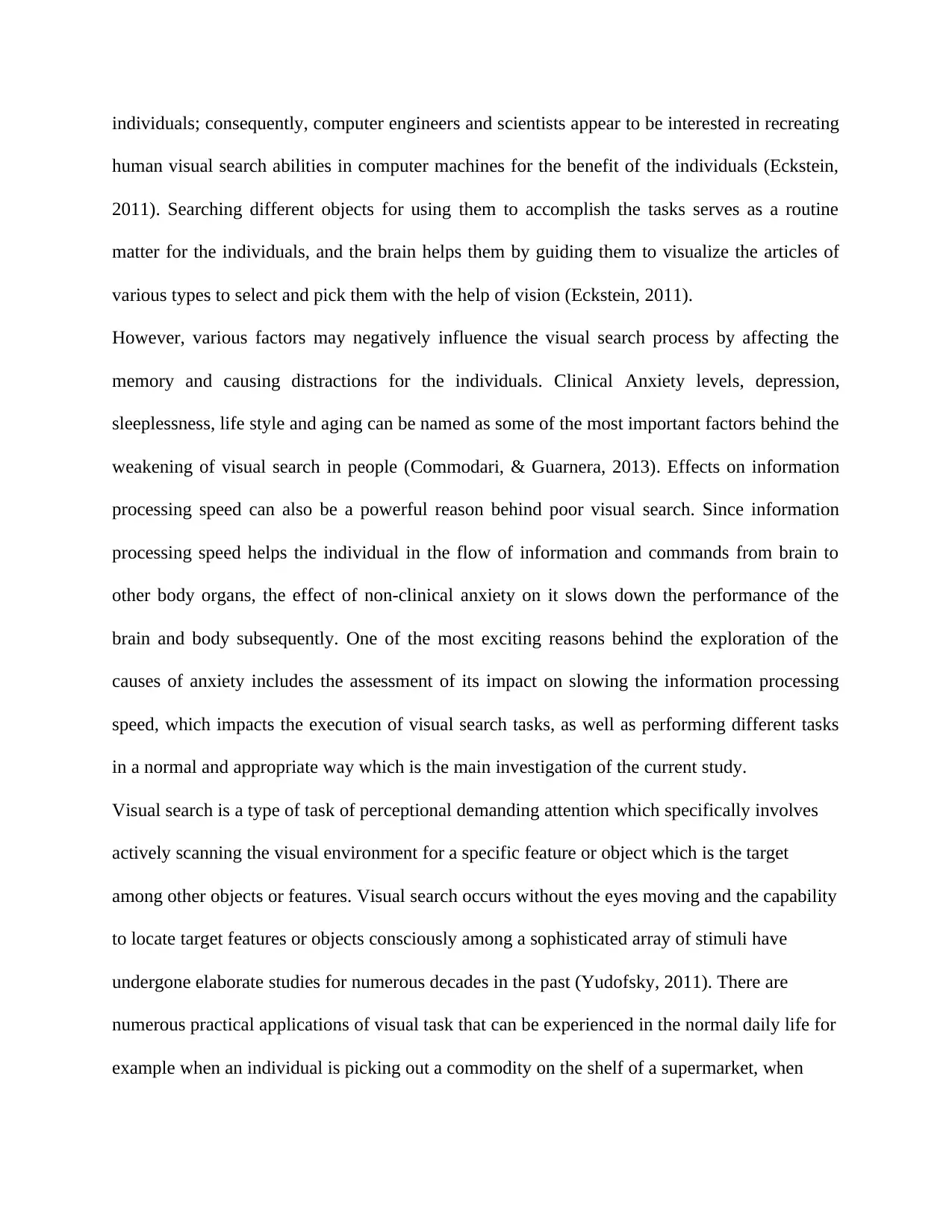
individuals; consequently, computer engineers and scientists appear to be interested in recreating
human visual search abilities in computer machines for the benefit of the individuals (Eckstein,
2011). Searching different objects for using them to accomplish the tasks serves as a routine
matter for the individuals, and the brain helps them by guiding them to visualize the articles of
various types to select and pick them with the help of vision (Eckstein, 2011).
However, various factors may negatively influence the visual search process by affecting the
memory and causing distractions for the individuals. Clinical Anxiety levels, depression,
sleeplessness, life style and aging can be named as some of the most important factors behind the
weakening of visual search in people (Commodari, & Guarnera, 2013). Effects on information
processing speed can also be a powerful reason behind poor visual search. Since information
processing speed helps the individual in the flow of information and commands from brain to
other body organs, the effect of non-clinical anxiety on it slows down the performance of the
brain and body subsequently. One of the most exciting reasons behind the exploration of the
causes of anxiety includes the assessment of its impact on slowing the information processing
speed, which impacts the execution of visual search tasks, as well as performing different tasks
in a normal and appropriate way which is the main investigation of the current study.
Visual search is a type of task of perceptional demanding attention which specifically involves
actively scanning the visual environment for a specific feature or object which is the target
among other objects or features. Visual search occurs without the eyes moving and the capability
to locate target features or objects consciously among a sophisticated array of stimuli have
undergone elaborate studies for numerous decades in the past (Yudofsky, 2011). There are
numerous practical applications of visual task that can be experienced in the normal daily life for
example when an individual is picking out a commodity on the shelf of a supermarket, when
human visual search abilities in computer machines for the benefit of the individuals (Eckstein,
2011). Searching different objects for using them to accomplish the tasks serves as a routine
matter for the individuals, and the brain helps them by guiding them to visualize the articles of
various types to select and pick them with the help of vision (Eckstein, 2011).
However, various factors may negatively influence the visual search process by affecting the
memory and causing distractions for the individuals. Clinical Anxiety levels, depression,
sleeplessness, life style and aging can be named as some of the most important factors behind the
weakening of visual search in people (Commodari, & Guarnera, 2013). Effects on information
processing speed can also be a powerful reason behind poor visual search. Since information
processing speed helps the individual in the flow of information and commands from brain to
other body organs, the effect of non-clinical anxiety on it slows down the performance of the
brain and body subsequently. One of the most exciting reasons behind the exploration of the
causes of anxiety includes the assessment of its impact on slowing the information processing
speed, which impacts the execution of visual search tasks, as well as performing different tasks
in a normal and appropriate way which is the main investigation of the current study.
Visual search is a type of task of perceptional demanding attention which specifically involves
actively scanning the visual environment for a specific feature or object which is the target
among other objects or features. Visual search occurs without the eyes moving and the capability
to locate target features or objects consciously among a sophisticated array of stimuli have
undergone elaborate studies for numerous decades in the past (Yudofsky, 2011). There are
numerous practical applications of visual task that can be experienced in the normal daily life for
example when an individual is picking out a commodity on the shelf of a supermarket, when
⊘ This is a preview!⊘
Do you want full access?
Subscribe today to unlock all pages.

Trusted by 1+ million students worldwide
1 out of 46
Related Documents
Your All-in-One AI-Powered Toolkit for Academic Success.
+13062052269
info@desklib.com
Available 24*7 on WhatsApp / Email
![[object Object]](/_next/static/media/star-bottom.7253800d.svg)
Unlock your academic potential
Copyright © 2020–2025 A2Z Services. All Rights Reserved. Developed and managed by ZUCOL.





